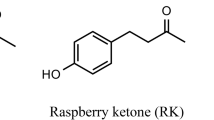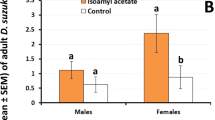Abstract
Previous laboratory tests revealed that exposure to oranges (Citrus sinensis L.) increased the mating success of male Mediterranean fruit flies, Ceratitis capitata (Wiedemann) (medfly). This advantage may have resulted from male exposure to α-copaene (a sesquiterpene hydrocarbon and known male attractant) in the peel, as pure α-copaene has been shown to increase the mating success of male medflies. Working with orange trees as well, we investigated whether male exposure to nonfruiting trees, leaves (also known to contain α-copaene albeit at a lower concentration than fruit), and fruit conferred a mating advantage to wild-like males in field-cage tests. Males exposed to entire nonfruiting trees or leaves had a mating advantage over control males (exposed to a nonhost plant) in trials conducted 1 day but not 3 days after exposure. Males exposed to orange fruits had higher mating success than control males (exposed to apples) in trials conducted 1 and 3 days after exposure. Enhanced mating success was observed only when males were permitted to contact the orange leaves and fruits; aroma alone did not affect male mating success. In addition, we examined whether exposure to commercially available orange oil, which also contains α-copaene, enhanced the mating performance of wild-like and mass-reared sterile males. Heightened mating success was observed in trials conducted 1 and 3 days after exposure for both types of males, and in this case aroma alone had a positive effect on male mating success. Future research should attempt to identify the behavioral, physiological, or chemical mechanisms underlying the observed increases in male mating success.
Similar content being viewed by others
reference
Bradbury, J. W., and Gibson, R. M. (1983). Leks and mate choice. In Bateson, P. (ed.), Mate Choice, Cambridge University Press, Cambridge, pp. 109-138.
Field, S. A., Kaspi, R., and Yuval, B. (2002). Why do calling medflies (Diptera: Tephritidae) cluster? Assessing the empirical evidence for models of medfly lek evolution. Fla. Entomol. 85: 63-72.
Flath, R. A., Cunningham, R. T., Mon, T. R., and John, J. O. (1994a). Males lures for Mediterranean fruit fly (Ceratitis capitata Wied.): Attractants from angelica seed oil (Angelica archangelica L.). J. Chem. Ecol. 20: 1969-1984.
Flath, R. A., Cunningham, R. T., Mon, T. R., and John, J. A. (1994b). Males lures for Mediterranean fruit fly (Ceratitis capitata Wied.): Structural analogues of α-copaene. J. Chem. Ecol. 20: 2595-2609.
Greenfield, M. D. (1997). Sexual selection in resource defense polygyny: Lessons from territorial grasshoppers. In Choe, J. C., and Crespi, B. J. (eds.), The Evolution of Mating Systems in Insects and Arachnids, Cambridge University Press, Cambridge, pp. 75-88.
Hee, A. K. W., and Tan, K. H. (1998). Attraction of female and male Bactrocera papayae to conspecific males fed with methyl eugenol and attraction of females to male sex pheromone components. J. Chem. Ecol. 24: 753-764.
Hendrichs, J., Robinson, A. S., Cayol, J. P., and Enkerlin, W. (2002). Medfly areawide sterile insect technique programmes for prevention, suppression or eradication: The importance of mating behavior studies. Fla. Entomol. 85: 1-13.
Jaffe, K., Sanchez, P., Cerda, H., Hernandez, J. V., Jaffe, R., Urdaneta, N., Guerra, G., Martinez, R., and Miras, B. (1993). Chemical ecology of the palm weevil Rhynchophorus palmarum L. (Coleoptera: Curculionidae): Attraction to host plants and to a male produced pheromone. J. Chem. Ecol. 19: 1703-1720.
Krasnoff, S. B., and Dussourd, D. E. (1989). Dihydropyrrolizidine attractants for arctiid moths that visit plants containing pyrrolizidine alkaloids. J. Chem. Ecol. 15: 47-60.
Lofstedt, C., Vickers, N. J., Roelofs, W. L., and Baker, T. C. (1989). Diet related courtship success in the Oriental fruit month, Grapholita molesta (Tortricidae). Oikos 55: 402-408.
Mangan, R. L. (1979). Reproductive behavior of the cactus fly, Odontoloxozus longicornis, male territoriality and female guarding as adaptive strategies. Behav. Ecol. Sociobiol. 4: 265-278.
Millar, J. G. (1995). An overview of attractants for the Mediterranean fruit fly. In Morse, J. G., Metcalf, R. L., and Dowell, R. V. (eds.), The Medfly in California: Defining Critical Research, University of California, Center for Exotic Pest Research, Riverside, pp. 123-143.
Nishida, R., Iwahashi, O., and Tan, K. H. (1993). Accumulation of Dendrobium superbum (Orchidaceae) fragrance in the rectal glands by males of the melon fly, Dacus cucurbitae. J. Chem. Ecol. 19: 713-722.
Nishida, R., Shelly, T. E., and Kaneshiro, K. Y. (1997). Acquisition of female attractive fragrance by males of the oriental fruit fly from a Hawaiian lei flower, Fagraea berteriana. J. Chem. Ecol. 23: 2275-2285.
Nishida, R., Shelly, T. E., Whittier, T. S., and Kaneshiro, K. Y. (2000). α-Copaene, a potential rendezvous cue for the Mediterranean fruit fly, Ceratitis capitata? J. Chem. Ecol. 26: 87-100.
Oliveros-Belardo, L., Smith, L., Robinson, R. M., and Albano, V. (1986). A chemical study of the essential oil from the fruit peeling of Psidium guajava L. Philipp. J. Sci. 115: 1-9.
Papadopoulos, N. T., Katsoyannos, B. I., Kouloussis, N. A., and Hendrichs, J. (2001). Effect of orange peel substances on mating competitiveness of male Ceratitis capitata. Entomol. Exp. Appl. 99: 253-261.
Phillips, T. W., West, J. R., Foltz, R. M., Silverstein, R. M., and Lanier, G. N. (1984). Aggregation pheromone of the deodar weevil, Pissodes nemorensis (Coleoptera: Curculionidae): Isolation and activity of grandisol and grandisal. J. Chem. Ecol. 10: 1417-1423.
Shelly, T. E. (2000). Flower-feeding affects mating performance in male oriental fruit fly Bactrocera dorsalis. Ecol. Entomol. 25: 109-114.
Shelly, T. E. (2001). Exposure to α-copaene and α-copaene-containing oils enhances mating success of male Mediterranean fruit flies (Diptera: Tephritidae). Ann. Entomol. Soc. Am. 94: 497-502.
Shelly, T. E. (2002). Feeding on papaya flowers enhances mating competitiveness of male oriental fruit flies Bactrocera dorsalis (Diptera: Tephritidae). Proc. Hawaii. Entomol. Soc. 35: 41-47.
Shelly, T. E., and Dewire, A. M. (1994). Chemically mediated mating success in male oriental fruit flies, Bactrocera dorsalis (Diptera: Tephritidae). Ann. Entomol. Soc. Am. 87: 375-382.
Shelly, T. E., and McInnis, D. O. (2001). Exposure to ginger root oil enhances mating success of irradiated, mass-reared males of the Mediterranean fruit fly (Diptera: Tephritidae). J. Econ. Entomol. 94: 1413-1418.
Shelly, T. E., and Villalobos, E. (2004). Host-plant influence on the mating success of male Mediterranean fruit flies: Variable effects within and between individual plants(in press).
Takeoka, G., Flath, R. A., Mon, T. R., Buttery, R. G., Teranishi, R., Guntert, M., Lautamo, R., and Szejtli, J. (1990). Further applications of permethylated β-cyclodextrin capillary gas chromatographic columns. J. High Resol. Chromatogr. 13: 202-206.
Tan, K. H., and Nishida, R. (1996). Sex pheromone and mating competition after methyl eugenol consumption in the Bactrocera dorsalis complex. In McPheron, B. A., and Steck, G. J. (eds.), Fruit Fly Pests: A World Assessment of Their Biology and Management, St. Lucie Press, Delray Beach, FL, pp. 147-153.
Tan, K. H., and Nishida, R. (2000). Mutual reproductive benefits between a wild orchid, Bulbophyllum patens, and Bactrocera fruit flies via a floral syndrome. J. Chem. Ecol. 26: 533-546.
Tanaka, N., Steiner, L. F., Ohinata, K., and Okamoto, R. (1969). Low-cost larval rearing medium for mass production of oriental and Mediterranean fruit flies. J. Econ. Entomol. 62: 967-968.
Teranishi, R., Buttery, R. G., Matsumoto, K. E., Stern, D. J., Cunningham, R. T., and Gothilf, S. (1987). Recent developments in the chemical attractants for tephritid fruit flies. ACS Symp. Ser. 330: 431-438.
Author information
Authors and Affiliations
Corresponding author
Rights and permissions
About this article
Cite this article
Shelly, T., Dang, C. & Kennelly, S. Exposure to Orange (Citrus sinensis L.) Trees, Fruit, and Oil Enhances Mating Success of Male Mediterranean Fruit Flies (Ceratitis capitata [Wiedemann]). Journal of Insect Behavior 17, 303–315 (2004). https://doi.org/10.1023/B:JOIR.0000031532.29287.95
Issue Date:
DOI: https://doi.org/10.1023/B:JOIR.0000031532.29287.95




